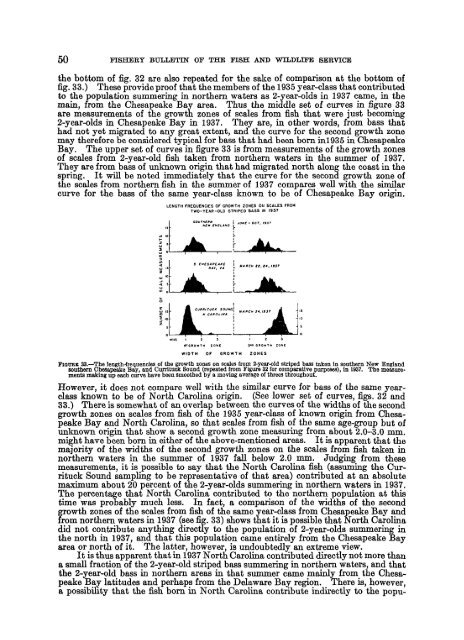Fishery bulletin of the Fish and Wildlife Service - NOAA
Fishery bulletin of the Fish and Wildlife Service - NOAA
Fishery bulletin of the Fish and Wildlife Service - NOAA
Create successful ePaper yourself
Turn your PDF publications into a flip-book with our unique Google optimized e-Paper software.
50 FISHERY BULLETIN OF THE FISH AND WILDLIFE SERVICE<br />
<strong>the</strong> bottom <strong>of</strong> fig. 32 are also repeated for <strong>the</strong> sake <strong>of</strong> comparison at <strong>the</strong> bottom <strong>of</strong><br />
fig. 33.) These provide pro<strong>of</strong> that <strong>the</strong> members <strong>of</strong> <strong>the</strong> 1935 year-class that contributed<br />
to <strong>the</strong> population summering in nor<strong>the</strong>rn waters as 2-year-olds in 1937 came, in <strong>the</strong><br />
main, from <strong>the</strong> Chesapeake Bay area. Thus <strong>the</strong> middle set <strong>of</strong> curves in figure 33<br />
are measurements <strong>of</strong> <strong>the</strong> growth zones <strong>of</strong> scales from fish that were just becoming<br />
2-year-olds in Chesapeake Bay in 1937. They are, in o<strong>the</strong>r words, from bass that<br />
had not yet migrated to any great extent, <strong>and</strong> <strong>the</strong> curve for <strong>the</strong> second growth zone<br />
may <strong>the</strong>refore be considered typical for bass that had been born inl935 in Chesapeake<br />
Bay. The upper set <strong>of</strong> curves in figure 33 is from measurements <strong>of</strong> <strong>the</strong> growth zones<br />
<strong>of</strong> scales from 2-year-old fish taken from nor<strong>the</strong>rn waters in <strong>the</strong> summer <strong>of</strong> 1937.<br />
They are from bass <strong>of</strong> unknown origin that had migrated north along <strong>the</strong> coast in <strong>the</strong><br />
spring. It will be noted immediately that <strong>the</strong> curve for <strong>the</strong> second growth zone <strong>of</strong><br />
<strong>the</strong> scales from nor<strong>the</strong>rn fish in <strong>the</strong> summer <strong>of</strong> 1937 compares well with <strong>the</strong> similar<br />
curve for <strong>the</strong> bass <strong>of</strong> <strong>the</strong> same year-class known to be <strong>of</strong> Chesapeake Bay origin.<br />
LENGTH FREQUENCIES OF GROWTH ZONES ON SCALES FROM<br />
TWO-YEAR-OLD STRIPED BASS IN 1937<br />
WIDTH OF GROWTH<br />
FIGURE 33.—The length-frequencies <strong>of</strong> <strong>the</strong> growth zones on scales from 2-year-old striped bass taken In sou<strong>the</strong>rn New Engl<strong>and</strong><br />
sou<strong>the</strong>rn Chesapeake Bay, <strong>and</strong> Currituck Sound (repeated from Figure 32 for comparative purposes), in 1937. The measurements<br />
making up each curve have been smoo<strong>the</strong>d by a moving average <strong>of</strong> threes throughout.<br />
However, it does not compare well with <strong>the</strong> similar curve for bass <strong>of</strong> <strong>the</strong> same yearclass<br />
known to be <strong>of</strong> North Carolina origin. (See lower set <strong>of</strong> curves, figs. 32 <strong>and</strong><br />
33.) There is somewhat <strong>of</strong> an overlap between <strong>the</strong> curves <strong>of</strong> <strong>the</strong> widths <strong>of</strong> <strong>the</strong> second<br />
growth zones on scales from fish <strong>of</strong> <strong>the</strong> 1935 year-class <strong>of</strong> known origin from Chesapeake<br />
Bay <strong>and</strong> North Carolina, so that scales from fish <strong>of</strong> <strong>the</strong> same age-group but <strong>of</strong><br />
unknown origin that show a second growth zone measuring from about 2.0-3.0 mm.<br />
might have been born in ei<strong>the</strong>r <strong>of</strong> <strong>the</strong> above-mentioned areas. It is apparent that <strong>the</strong><br />
majority <strong>of</strong> <strong>the</strong> widths <strong>of</strong> <strong>the</strong> second growth zones on <strong>the</strong> scales from fish taken in<br />
nor<strong>the</strong>rn waters in <strong>the</strong> summer <strong>of</strong> 1937 fall below 2.0 mm. Judging from <strong>the</strong>se<br />
measurements, it is possible to say that <strong>the</strong> North Carolina fish (assuming <strong>the</strong> Currituck<br />
Sound sampling to be representative <strong>of</strong> that area) contributed at an absolute<br />
maximum about 20 percent <strong>of</strong> <strong>the</strong> 2-year-olds summering in nor<strong>the</strong>rn waters in 1937.<br />
The percentage that North Carolina contributed to <strong>the</strong> nor<strong>the</strong>rn population at this<br />
time was probably much less. In fact, a comparison <strong>of</strong> <strong>the</strong> widths <strong>of</strong> <strong>the</strong> second<br />
growth zones <strong>of</strong> <strong>the</strong> scales from fish <strong>of</strong> <strong>the</strong> same year-class from Chesapeake Bay <strong>and</strong><br />
from nor<strong>the</strong>rn waters in 1937 (see fig. 33) shows that it is possible that North Carolina<br />
did not contribute anything directly to <strong>the</strong> population <strong>of</strong> 2-year-olds summering in<br />
<strong>the</strong> north in 1937, <strong>and</strong> that this population came entirely from <strong>the</strong> Chesapeake Bay<br />
area or north <strong>of</strong> it. The latter, however, is undoubtedly an extreme view.<br />
It is thus apparent that in 1937 North Carolina contributed directly not more than<br />
a small fraction <strong>of</strong> <strong>the</strong> 2-year-old striped bass summering in nor<strong>the</strong>rn waters, <strong>and</strong> that<br />
<strong>the</strong> 2-year-old bass in nor<strong>the</strong>rn areas in that summer came mainly from <strong>the</strong> Chesapeake<br />
Bay latitudes <strong>and</strong> perhaps from <strong>the</strong> Delaware Bay region. There is, however,<br />
a possibility that <strong>the</strong> fish born in North Carolina contribute indirectly to <strong>the</strong> popu-

















